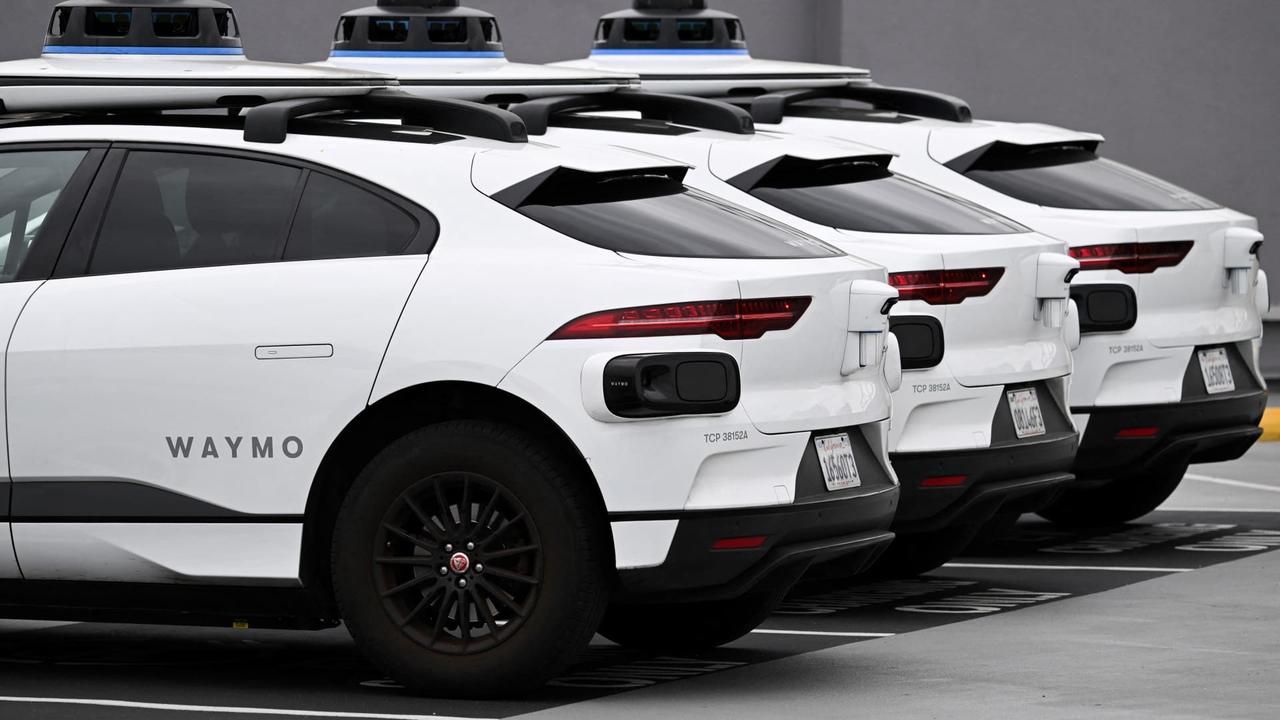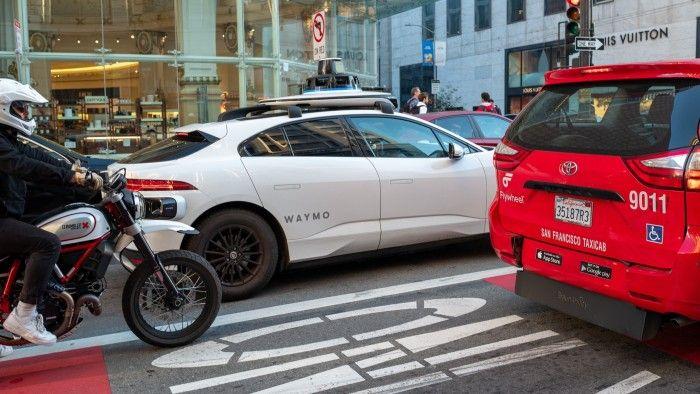Waymo Accelerates Autonomous Vehicle Expansion with Five New Cities in 2026
6 Sources
6 Sources
[1]
Waymo Self-Driving Cars Are Coming to 5 More Cities Next Year
Waymo will soon double the amount of cities where you can ride in its fully autonomous self-driving cars. The brand announced on Tuesday it would be bringing its rider-only service to Dallas, Houston, Orlando, Miami, and San Antonio in 2026 Employees are now able to ride in the vehicles without onboard operators in Miami, and the other four cities will get the same testing in the "coming weeks." An exact launch date for the full service remains unclear. Waymo's news adds these five cities on top of its services in Atlanta, Austin, Los Angeles, Phoenix, and San Francisco. The brand's blog post talks through how it makes decisions of when to launch in a new city. It says, "We compare our driving performance against a proven baseline to validate the performance of the Waymo Driver and identify any unique local characteristics. As needed, we then refine the Waymo Driver's AI to navigate these local nuances -- which are becoming fewer with every city." Waymo has ramped up its services throughout 2025 as competition from alternatives, such as Tesla and Zoox, have gained momentum. Zoox, which is owned by Amazon, announced on Tuesday it will soon begin to offer its robotaxi service to customers in San Francisco. It plans to offer free rides at first to help it challenge Waymo's lead. You can now sign up for Zoox's waitlist through its Android and iOS apps. Waymo has previously announced testing in further cities, including Detroit, Las Vegas, Nashville, New York City, San Diego, and Washington D.C. It is also testing in Tokyo, Japan, and London, United Kingdom. Last week, Waymo said it will now allow its vehicles to drive on highways for the first time in Los Angeles, Phoenix, and San Francisco to help speed up journeys for its customers.
[2]
Watch Out, Uber Drivers: Waymo Robotaxis Are Now Allowed on Highways
Emily is an experienced reporter who covers cutting-edge tech, from AI and EVs to brain implants. She stays grounded by hiking and playing guitar. Don't miss out on our latest stories. Add PCMag as a preferred source on Google. Waymo autonomous cars can now ride on highways in San Francisco, Phoenix, and Los Angeles, meaning the app will no longer route cars on backroads to avoid the freeway. When we tried a Waymo in Los Angeles last month, the trips took about 10-15 minutes longer than indicated on Google Maps because they avoided freeways, making Lyfts or Ubers with human driver a more attractive option when in a rush. That problem is now solved for three of the five cities where Waymo operates. "Achieving fully autonomous freeway operations is a profound engineering feat -- easy to conceive, yet hard to truly master," says Waymo co-CEO Dmitri Dolgov. "This milestone is a powerful testament to the maturity of our operations and technology." Waymo has been testing freeway trips for over a year with employees and guests as passengers, a company spokesperson tells us. The software behind the cars, the Waymo Driver, has also racked up "millions of autonomous miles," as well as performed "closed-course validation, and extensive simulation testing to ensure a safe, reliable rider experience." Riders will still call a car through the Waymo app, where they can indicate their interest for taking freeway routes. The software will program a route that includes them when it is "meaningfully faster," Waymo says. The remaining two major cities Waymo services, Austin and Atlanta, do not yet have access to freeway routes. The company plans to introduce them there over time. In those cities, Waymo allows riders to call a car through the Uber app. Also today, Waymo expanded its San Francisco Bay Area service to San Jose, including curbside access at San Jose Mineta International Airport. Many major tech companies have offices in the area, including Apple, IBM, Nvidia, and Google, so their employees may now enjoy an autonomous ride to work. It's also testing (with a human driver) at San Francisco International. The Alphabet-owned company continues to operate in a league of its own, with no major competition following the demise of GM's Cruise robotaxis. Tesla has a small fleet of 10 to 20 Model Y robotaxis in Austin, with plans to get to 500 by the end of the year, and another 1,000 in San Francisco, Teslarati reports. In California, Tesla will have a human monitor behind the wheel until it obtains the permits to operate without one. It's also applied to do the same in Phoenix.
[3]
Waymo soft-launches driverless taxis in Miami, but you can't hail a cyber-cab yet
It might just be a self-driving taxi, which Waymo began testing on Miami roads Tuesday. Why it matters: The ride-hailing company -- which currently operates in several U.S. cities from Los Angeles to Atlanta -- is planning to launch in Miami, Orlando and across Texas in 2026. The latest: After first using drivers to test Waymo's electric Jaguar I-PACE vehicles in Miami, the company Tuesday began operating a limited number of fully driverless vehicles with Waymo employees as passengers. * The cars are not using the highways -- yet -- but Waymo does operate on freeways in California and Arizona, a spokesperson told Axios. * The company is taking its cars across Miami-Dade County, from Doral to Bal Harbour to South Miami and more, the spokesperson said. * "As we've done in the past, we'll gradually expand our operations over time." State of play: Miami has long been a testing ground for self-driving vehicles -- thanks to the city's tropical weather and unpredictable driving conditions. * Companies like Ford, Lyft and Amazon-owned Zoox have tested their vehicles on our streets. * Last month, the Miami-Dade Sheriff's Office rolled out a new autonomous police cruiser. How it works: Waymo -- owned by Google parent company Alphabet -- says its cars are controlled by a "demonstrably safe AI" system that is trained through real-world driving and advanced simulation. * When entering a new city, the company says it compares its driving performance against a baseline to measure outcomes and "identify any unique local characteristics." * "As needed, we then refine the Waymo Driver's AI to navigate these local nuances -- which are becoming fewer with every city," Waymo said in a press release. Friction point In July, the National Highway Traffic Safety Administration closed a 14-month investigation into Waymo over a series of minor collisions and "unexpected behavior," deciding to take no action against the company, Reuters reported.
[4]
Waymo's Autonomous Taxis Are Coming To Five More U.S. Cities
After it's all said and done, Waymo will offer paid autonomous rides next year. Waymo will expand its driverless taxi service in five more American cities starting next year, the company said in a blog post. The Alphabet-owned robotaxi operator-the largest in the United States-has already removed safety operators from its cars in Miami and is now giving rides to employees. Over the following weeks, the same will happen in Dallas, Houston, San Antonio and Orlando, ahead of rolling out paid rides in vehicles with nobody inside in 2026. Waymo already operates in the San Francisco Bay Area, Los Angeles, Phoenix, Atlanta and Austin, but the company's expansion plans don't end here, as it plans to add another 12 cities under its belt, including the United Kingdom's capital, London. The expansion plans come after a big milestone for the Alphabet-owned entity: offering paid rides on highways in San Francisco, Los Angeles and Phoenix. Waymo claims its autonomous driving suite has over 100 million miles of real-world driving experience through all sorts of situations. In its blog post, the robotaxi operator sounds very confident in the technology it has developed: "We haven't just built the technology; we've developed the definitive playbook for operating autonomous fleets, across dozens of sites, and industry-leading end-to-end rider support." There's no denying that Waymo has the high ground here, and it knows it, but the American autonomous taxi space has changed dramatically in the last decade. Alphabet's robotaxi company is facing increasing competition from Amazon-owned Zoox, which recently announced it will offer free rides in its purpose-built pods in San Francisco, in addition to Las Vegas. (Zoox also has the country's first bespoke AV factory.) Tesla is also gearing up to expand its Robotaxi service. After debuting in Austin earlier this year, the Elon Musk-led robotics and AI company received a ride-hailing permit from the state of Arizona, which allows it to offer paid rides in driverless cars. (Tesla also has a small-scale service in San Francisco, where Tesla employees drive Model Y EVs.) What's more, the National Highway Traffic Safety Administration (NHTSA) opened an investigation last month, after a Waymo robotaxi was spotted driving around a school bus that had its red lights flashing. The federal body's Office of Defects Investigation (ODI) said it will investigate the performance of Waymo's self-driving software around stopped school buses.
[5]
Waymo announces expansion: autonomous rides coming to Miami, Dallas, Houston, and more
Waymo is significantly accelerating its rollout. After years of slow and methodical expansion, the Alphabet-owned company is now moving at a faster speed, announcing today that it is bringing its autonomous driving technology to five new major cities, starting with Miami. This comes just days after the company finally unlocked driverless freeway rides for passengers in its core markets. For a long time, the criticism of Waymo was that while its technology was impressive, it couldn't scale. It took them years to go from a geofenced area in Chandler, Arizona, to covering the full metro area of Phoenix and expanding to San Francisco. But that narrative is officially dead. In a press release titled "Safe, routine, ready: Autonomous driving in new cities," Waymo confirmed it is launching operations in Miami, Dallas, Houston, San Antonio, and Orlando. The company says operations start today in Miami, with the other four cities following in the "coming weeks." Tekedra Mawakana, Waymo's co-CEO, commented on the expansion: "Safe, routine, ready... We've built a generalizable Driver, powered by Waymo's demonstrably safe AI, and an operational playbook to reliably achieve this milestone." It's worth noting the distinction here between "operations" and "commercial rides." Waymo says it is starting operations (likely testing) now, with plans to "open our doors to riders next year." This aligns with their recent strategy in Austin and Atlanta, where they tested for a few months before opening up the app to the public. With today's news, Waymo's map is getting quite a bit more crowded - albeit with some asterisks. Here is the current breakdown of where the service is live and where it is coming next: The inclusion of three more Texas cities (Dallas, Houston, San Antonio) alongside Austin means Waymo is effectively aiming to cover the "Texas Triangle," a massive transportation corridor. It is made possible by Texas's relaxed autonomous-driving laws. This expansion follows the huge milestone earlier this month when Waymo began allowing rider-only trips on freeways in Phoenix, SF, and LA, a capability that is essential for competing with human Uber/Lyft drivers on longer routes. I sure hope we are going to start the calls of "Waymo can't scale" fade away. In the next few months, Waymo will be operating driverless in 10 of the biggest cities in the US. No one else is doing that in North America right now. There are companies in China that have similar deployment capabilities, but that's about it. Tesla shareholders will try to tell you that the automaker is right on Waymo's heels. Still, Tesla is currently operating something it calls "Robotaxi" that requires a safety driver inside at all times. Even if Tesla is set up to scale faster, it is still not at square one when it comes to operating an autonomous vehicle ride-hailing service.
[6]
Waymo Now Operates On More Highways Than Tesla Robotaxi With New Expansion, But There's One Key Difference - Alphabet (NASDAQ:GOOG)
Tesla Inc.'s (NASDAQ:TSLA) Robotaxi ambitions face yet another challenge as Alphabet Inc.'s (NASDAQ:GOOGL) (NASDAQ:GOOG) autonomous vehicle company Waymo announced the expansion of its self-driving cabs on highways in multiple cities. Waymo To Operate On Highways In California, Arizona In a blog post published by the company on Wednesday, Waymo announced that it was expanding its service to operate on highways in Phoenix, Arizona, as well as the San Francisco Bay Area and Los Angeles in California. Waymo announced it will operate in the entire peninsula area spanning from "San Francisco all the way down to San Jose, including curbside service at San Jose Mineta International Airport." It's worth noting that Waymo will operate the service on freeways without the presence of an onboard safety driver. "Sign up today to be among the first to access Waymo freeway trips," the company said. Tesla's Robotaxi Expansion The news comes as Tesla CEO Elon Musk, during the company's third-quarter earnings call last month, said that Robotaxis -- powered by a camera-based system rather than LiDAR sensors -- in Austin, Texas, will go driverless by the end of the year. Tesla currently offers Robotaxis in the city, including its highways, with an onboard safety operator. Musk had also claimed that the company would now target expanding into 8-10 major cities across the U.S., backtracking from his earlier promise of serving over 50% of the U.S. population with Robotaxis. Tekedra Mawakana Reiterates Transparency, Apollo Go Reaches 250K Rides Per Week Meanwhile, Waymo CEO Tekedra Mawakana reiterated the importance of maintaining transparency to ensure better safety on the roads. "It is my view that you [the companies] are not doing what's necessary to earn the right to make the roads safer," Mawakana had said. Elsewhere, Chinese tech company Baidu Inc.'s (NASDAQ:BIDU) Robotaxi service Apollo Go recently announced it reached the 250,000 autonomous rides per week milestone. The company announced it has clocked over 140 million driverless miles. Check out more of Benzinga's Future Of Mobility coverage by following this link. Read Next: Tesla's Former AI Lead Andrej Karpathy Compares FSD's 'Flawless' HW4 Drive With Magnetic Levitation Train: 'Basically... I'm Amazed' Photo courtesy: Sundry Photography / Shutterstock.com GOOGAlphabet Inc$286.59-1.77%OverviewBIDUBaidu Inc$129.00-2.24%GOOGLAlphabet Inc$286.01-1.82%TSLATesla Inc$428.70-2.48%Market News and Data brought to you by Benzinga APIs
Share
Share
Copy Link
Waymo announces major expansion plans to bring driverless taxi services to Miami, Dallas, Houston, Orlando, and San Antonio in 2026, doubling its operational footprint while introducing highway capabilities in existing markets.
Waymo Announces Ambitious Expansion Plans
Waymo, the autonomous vehicle subsidiary of Alphabet, has announced plans to bring its fully driverless taxi service to five additional major cities in 2026, marking the most significant expansion in the company's history
1
. The new markets include Miami, Dallas, Houston, Orlando, and San Antonio, effectively doubling the number of cities where consumers can access Waymo's rider-only service4
.
Source: InsideEVs
The rollout has already begun in Miami, where Waymo employees are currently testing fully autonomous vehicles without onboard operators
3
. The remaining four cities will receive similar employee testing in the "coming weeks," with full commercial service launching throughout 20265
.Highway Operations Represent Major Breakthrough
In a significant technological milestone, Waymo has begun allowing its autonomous vehicles to operate on highways in San Francisco, Phoenix, and Los Angeles
2
. This development addresses a key competitive disadvantage that previously made Waymo trips 10-15 minutes longer than traditional ride-hailing services, as vehicles were forced to use surface streets to avoid freeways."Achieving fully autonomous freeway operations is a profound engineering feat -- easy to conceive, yet hard to truly master," said Waymo co-CEO Dmitri Dolgov
2
. The company has been testing freeway operations for over a year with employees and has accumulated millions of autonomous miles through simulation and closed-course validation.
Source: PC Magazine
Strategic Focus on Texas Triangle
The inclusion of three Texas cities - Dallas, Houston, and San Antonio - alongside existing operations in Austin represents a strategic focus on the "Texas Triangle," a massive transportation corridor connecting the state's major metropolitan areas
5
. This expansion is facilitated by Texas's relatively permissive autonomous driving regulations, which allow for faster deployment of driverless technology.Waymo's approach to new market entry involves comparing driving performance against established baselines to validate the Waymo Driver system and identify unique local characteristics
1
. The company refines its AI to navigate local nuances, which it says are "becoming fewer with every city" as the technology matures.Related Stories
Competitive Landscape and Market Position
The expansion comes as competition in the autonomous vehicle space intensifies. Amazon-owned Zoox announced plans to begin offering free robotaxi rides in San Francisco to challenge Waymo's market leadership
1
. Tesla is also expanding its robotaxi service, with plans to operate 500 vehicles in Austin by year-end and 1,000 in San Francisco, though these still require human safety drivers2
.With the new expansion, Waymo will operate driverless vehicles in 10 major US cities, maintaining its position as the dominant autonomous vehicle operator in North America
5
. The company currently provides services in Atlanta, Austin, Los Angeles, Phoenix, and San Francisco, with additional testing underway in international markets including Tokyo and London.
Source: Benzinga
Regulatory Oversight and Safety Considerations
The National Highway Traffic Safety Administration closed a 14-month investigation into Waymo in July, deciding to take no action after examining a series of minor collisions and "unexpected behavior" incidents
3
. However, federal regulators opened a new investigation last month regarding a Waymo vehicle's behavior around a stopped school bus with flashing red lights4
.References
Summarized by
Navi
Related Stories
Recent Highlights
1
AI Chatbots Sway Voters More Effectively Than Traditional Political Ads, New Studies Reveal
Science and Research

2
OpenAI declares code red as Google's Gemini 3 gains 200 million users in three months
Technology

3
Trump approves Nvidia H200 chip exports to China with 25% revenue cut, defying Senate concerns
Policy and Regulation







